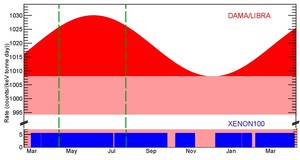Nikhef new XENON100 analysis refutes a long-standing claim of dark matter detection

The measured rate of interactions in the DAMA/LIBRA (red)
and XENON100 (blue) detectors. The observed
modulation of the DAMA/LIBRA signal has
been interpreted as due to dark matter interactions.
XENON100 should have seen a very similar
behavior if that interpretation were correct. However,
the more than 100x lower interaction rate measured in
XENON100 excludes this interpretation at more than 4.4 sigma.
A new XENON100 analysis, published in Science this week, refutes a long-standing claim of dark matter detection. Dark matter is an abundant but unseen matter in the universe considered largely responsible for the gravitational force that keeps the Milky Way galaxy together. According to most current theoretical models, the hypothetical dark matter particles interact with atomic nuclei. However, such interactions have not been detected to date. The scientists of the XENON collaboration have developed novel analysis techniques to search for the first time in the data of the XENON100 detector
The measured rate of interactions in the DAMA/LIBRA (red)
and XENON100 (blue) detectors. The observed
modulation of the DAMA/LIBRA signal has
been interpreted as due to dark matter interactions.
XENON100 should have seen a very similar
behavior if that interpretation were correct. However,
the more than 100x lower interaction rate measured in
XENON100 excludes this interpretation at more than 4.4 sigma.
A new XENON100 analysis, published in Science this week, refutes a long-standing claim of dark matter detection. Dark matter is an abundant but unseen matter in the universe considered largely responsible for the gravitational force that keeps the Milky Way galaxy together. According to most current theoretical models, the hypothetical dark matter particles interact with atomic nuclei. However, such interactions have not been detected to date. The scientists of the XENON collaboration have developed novel analysis techniques to search for the first time in the data of the XENON100 detector

